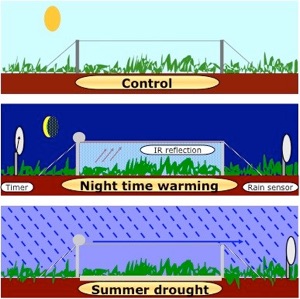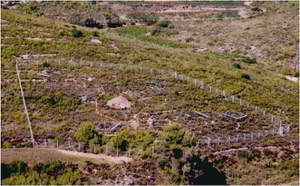Impacts of climate change on the genetic structure of Mediterranean shrub populations

Individual plant species are adapted to a particular range of climates, which represent the 'climate envelope' of the species. If populations of a species show local adaptation to regional climate, then a more specific climate envelope may apply to the local population.
The rapid changes in climate that are forecast for the future will cause climate envelopes to shift - leaving plants outside the climate to which they are adapted. Plants can respond through migration - physical movement of seeds, plant fragments and pollen to keep up with movement of their typical climate, and adaptation - evolutionary change to allow the species or population to cope better with the new climate it is subjected to. The precise mix of the two will vary for different species and in different environments. Those species that are unable to respond to the changing climate may ultimately go extinct.
Our recent work on European beech (Fagus sylvatica) has found evidence that current changes in climate are resulting in genetic changes in this forest tree. The work on beech was conducted in a large natural forest population subjected to increasing temperatures over the last quarter-century as a consequence of global climate change. Some beech individuals within the forest possess an allele that is linked to a region of the genome that is favoured by cooler temperatures but not by warmer ones. Thus, as the climate is warming, the frequency of this allele is decreasing within the population as natural selection favours those individuals in which it is absent.
Globularia alypum
In many areas throughout the world, long-term climatic manipulation experiments have been set up in an attempt to forecast the effects of future climate change on, amongst other things, plant physical and chemical characteristics and plant community composition.
In this study, based in the Garraf Natural Park in NE Spain, we are using one such long-term experiment, part of the Vulcan project, to see if experimentally applied drought and warming has led to parallel genetic changes in shrub species to those changes observed in beech.
This collaborative study, conducted with Josep Peñuelas and Francisco Lloret of CREAF, focuses on the Mediterranean shrubland species, Globularia alypum and Fumana thymifolia. These are species which show a decrease in seedling establishment in response to drought or warming treatments.
We are looking at whether the genetic effects of the climate treatments are random or selective. For example, if increased drought or temperature means that some individuals of these species can no longer establish in the community - what are the characteristics of those that can establish? Are they better adapted to the imposed climate - i.e. is the experiment causing evolutionary change, or is failure to establish a random process, affecting some individuals but not others purely by chance?
Our results so far suggest that, like the impacts we have seen on Fagus sylvatica, the effect of climate change on F. thymifolia does have a selective effect, leading to genetic changes within the population.
Related publications
Jump AS, Rico L, Lloret F, Peñuelas J (2009). Microspatial population genetic structure of the Mediterranean shrub Fumana thymifolia. Plant Biology, 11, 152-160.
Jump AS, Marchant R, Peñuelas J (2009). Environmental change and the option value of genetic diversity. Trends in Plant Science, 14, 51-58.
Jump AS, Peñuelas J, Rico L, Ramallo E, Estiarte M, Martínez-Izquierdo JA, Lloret F (2008). Simulated climate change provokes rapid genetic change in the Mediterranean shrub Fumana thymifolia. Global Change Biology, 14, 637–643.
Jump AS, Peñuelas J (2005). Running to stand still: adaptation and the response of plants to rapid climate change. Ecology Letters 8, 1010-1020.



Experimental climate treatments in the Garraf plots